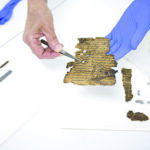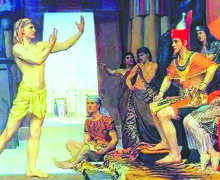
Génesis Apócrifo
Apocryphal Genesis
“He engendrado un hijo extraordinario. No es como un ser humano común; se parece más a los hijos de los ángeles del cielo. Su apariencia es diferente y no se asemeja a la nuestra. No parece ser mi hijo, sino más bien uno de los ángeles.” Estas palabras fueron dichas por Lamec a su padre, Matusalén, incluyendo la descripción de su hijo, “Tiene la piel blanca como la nieve y roja como una rosa; su cabellera es blanca, hermosa y rizada y, cuando abrió los ojos, toda la casa se iluminó como si el sol estuviera dentro”. Este pasaje es del libro de Noé, una antigua escritura hebrea relacionada con el Libro de Enoc, que se compiló en el siglo II a.C.
La conclusión de Lamec implicaría la infidelidad de su esposa Bathenosh, una mortal con un mensajero divino o Nefilim. Por supuesto que, para el escriba probablemente un Rabino, esto parece imposible ya que la religión judía sostiene que los ángeles son incorpóreos, no tienen sexo y, por lo tanto, no pueden reproducirse, estos preceptos fueron luego incorporados por el Cristianismo y el Islamismo.
El relato continúa cuando, ante la duda de su hijo, Matusalén emprende un viaje para encontrar a Enoc, su padre, quien vive en el “Parwain” o Paraíso, quien lo tranquiliza diciendo: “Tu hijo será un verdaderamente justo, llevara por nombre Noé, porque él y sus hijos serán salvos de la corrupción que vendrá sobre la tierra”.
Enoc confirma que en verdad algunos ángeles se enamoraron de mortales y engendraron hijos con ellas. “Y aconteció que cuando los hombres comenzaron a multiplicarse sobre la faz de la tierra, los Ángeles vieron que las hijas de los mortales eran hermosas, tomándolas para sí” (Génesis 6:1-2). Por esto en el versículo 4, se menciona: “Los Nefilim estaban en la tierra en aquellos días, cuando se unieron a las hijas de los hombres, engendrando hijos”.
Esto demuestra que incluso los más cercanos a la pureza divina, como los Ángeles, pueden ser corrompido, obligando a Dios a sanar la corrupción del mundo con el Diluvio.
Libro de Enoc
Este relato es parte de los Rollos Bíblicos, escritos en arameo por los Esenios entre el 170 a.C. hasta el 120 d.C., descubiertos a orillas del mar Muerto en 1947, en el sitio arqueológico conocido como Qumrán.
Los relatos del Libro de Genesis se recuperaron parcialmente, pero incluyen el nacimiento del hijo de Lamec, el relato del Arca de Noé, incluido el Diluvio y los viajes del patriarca Abraham.
En 1954 la Universidad Hebrea de Jerusalén publico estos textos, traducidos al hebreo y al inglés, con el título de “Génesis Apócrifo”, ya que el relato corrige muchos pasajes bíblicos.
Gracias a esos hallazgos en Qumrán, se descubrió que los Esenios fueron los primeros en escribir sobre la Kabbalah, mensajes de Dios transmitieron oralmente durante siglos.
Recordemos que los líderes de la Iglesia Cristiana Primitiva (siglos I al III d.C.) citaban estas ideas Kabbalísticas. Por esta razón Pablo, en 1 Corintios 11:10, solicita que las mujeres se cubran la cabeza, para no incitar a los ángeles caídos, según Tertuliano (160-230 d.C.).
En el siglo II d.C. el rabino Shimon Bar Yochai, primero que escribió sobre la Kabbalah, maldijo a aquellos que creían que los Ángeles pudieran tener forma corpórea.
En el siglo IV d.C. San Agustín solicitó que el Libro de Enoc no se incluyera en el Canon de las Escrituras por difamar ciertos mandatos de Dios, por supuesto que la idea de que existieran Ángeles entre los humanos despertó la curiosidad los primeros cristianos, llevando a los Padres de la Iglesia a condenar como herejía el uso de nombres de ángeles para sus hijos, incluso los escribas cristianos dejaron de copiar el Libro de Enoc, negando al mundo su contenido durante casi veinte siglos.
“I have begotten an extraordinary son. He is not like an ordinary human being; he resembles more the children of the angels of heaven. His appearance is different and does not resemble ours. He does not seem to be my son, but rather one of the angels.” These words were spoken by Lamech to his father, Methuselah, describing his son: “His skin is white as snow and red as a rose; his hair is white, beautiful, and curly, and when he opened his eyes, the whole house lit up as if the sun were inside.” This passage is from the Book of Noah, an ancient Hebrew scripture related to the Book of Enoch, compiled in the 2nd century BCE.
Lamech’s conclusion implies the infidelity of his wife Bathenosh, a mortal, with a divine messenger or Nephilim. However, for the scribe, probably a Rabbi, this seems impossible as Jewish religion holds that angels are incorporeal, have no gender, and therefore cannot reproduce. These precepts were later incorporated by Christianity and Islam.
The story continues with Methuselah, doubting his son’s claims, embarking on a journey to find Enoch, his father, who lives in the “Parwain” or Paradise. Enoch reassures him, saying: “Your son will be truly righteous, his name will be Noah, and he and his sons will be saved from the corruption that will come upon the earth.”
Enoch confirms that indeed some angels fell in love with mortals and fathered children with them. “When men began to multiply on the face of the earth, the angels saw that the daughters of men were beautiful and took them for themselves” (Genesis 6:1-2). Thus, in verse 4, it is mentioned: “The Nephilim were on the earth in those days, and also afterward, when the sons of God went to the daughters of humans and had children by them.” This demonstrates that even those closest to divine purity, such as the angels, can be corrupted, forcing God to cleanse the world’s corruption with the Flood.
Book of Enoch
This story is part of the Biblical Scrolls, written in Aramaic by the Essenes between 170 BCE and 120 CE, discovered on the shores of the Dead Sea in 1947, at the archaeological site known as Qumran.
The accounts from the Book of Genesis were partially recovered but include the birth of Lamech’s son, the story of Noah’s Ark, including the Flood, and the journeys of the patriarch Abraham.
In 1954, the Hebrew University of Jerusalem published these texts, translated into Hebrew and English, under the title “Apocryphal Genesis,” as the narrative corrects many biblical passages.
Thanks to these discoveries in Qumran, it was found that the Essenes were the first to write about the Kabbalah, messages from God transmitted orally for centuries.
We should remember that the leaders of the Early Christian Church (1st to 3rd centuries CE) cited these Kabbalistic ideas. For this reason, Paul, in 1 Corinthians 11:10, requests that women cover their heads, so as not to tempt the fallen angels, according to Tertullian (160-230 CE).
In the 2nd century CE, Rabbi Shimon Bar Yochai, the first to write about the Kabbalah, cursed those who believed that angels could take corporeal form.
In the 4th century CE, Saint Augustine requested that the Book of Enoch not be included in the Canon of Scripture for defaming certain mandates of God. Of course, the idea of angels existing among humans aroused the curiosity of early Christians, leading the Church Fathers to condemn as heresy the use of angelic names for their children. Even Christian scribes stopped copying the Book of Enoch, denying the world its content for almost twenty centuries.


























